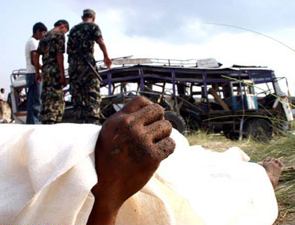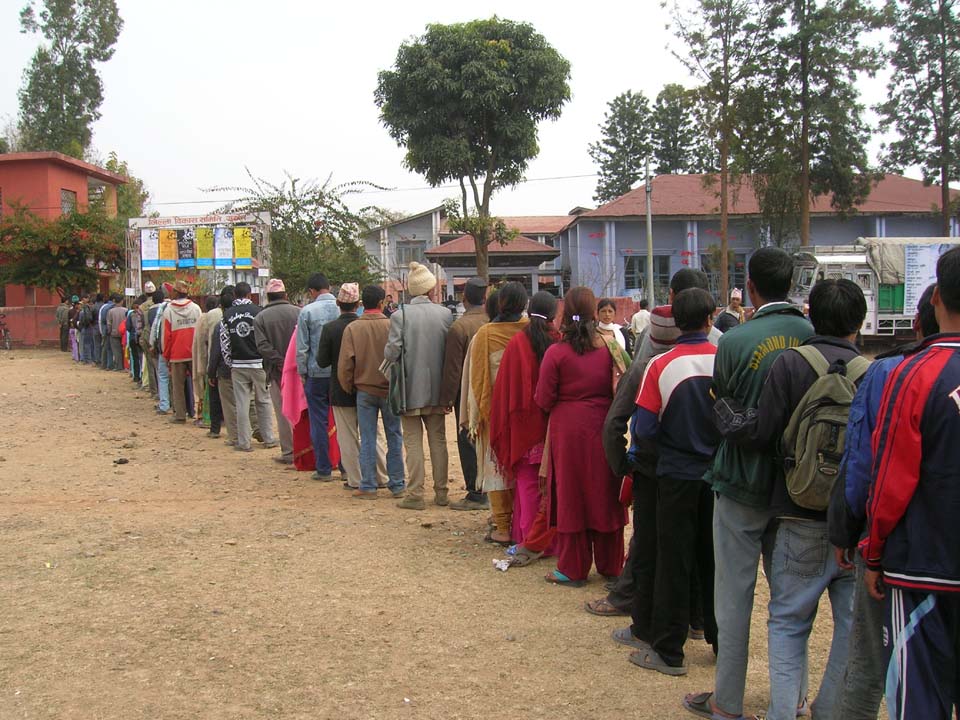Today we welcome guest correspondent David Campbell.
Photojournalism’s representation of war is often standardized, familiar, even clichéd. Regardless of the time or place it can seem like we have seen it before, regularly and repeatedly. But if we always approach the problem from the same vantage point – asking how the event is represented – we run the risk of missing vital dimensions and important effects of the image, as this picture from Nepal demonstrates.
This picture comes from that country’s decade-long civil war which ended in November 2006. The passenger was among 36 killed when Maoists bombed a bus near Madi in June 2005. As one of the 15,000 people who died in this period, he was an unknown statistic in what was, for the rest of the world, a forgotten conflict, an event that had disappeared from the radar even before it could be remembered.
We could read this image, which is being recirculated through a book launched at this year’s biennial Chobi Mela festival of photography, as the making visible of something we should have known about. Or it could be another testament to lives lost, marked by hands of death. Or we could see it as a further instance of the indirect marking of mass death, preserving dignity while recording loss. While such accounts provide understanding, they do not draw our attention to the larger significance of this image. If we shift our focus from representation to enactment, from meaning to work, we can appreciate this photograph for its vitality in the present rather than merely its record of the past.
As one of the 179 photographs by 80 photographers selected from the more than 2,000 submitted for the exhibition “A People War: Images of the Nepal Conflict 1996-2006,” this picture toured Nepal throughout 2008. As a book and exhibition, “A People War” contains what individually might be regarded as unremarkable images in the global archive of war photography. Its catalogue of uniformed guerrillas, grieving widows, destroyed infrastructure, damaged individuals and mobilizing soldiers could, by themselves, have been drawn from any number of conflicts. Despite the editors desire to forgo showing unvarnished violence (hence the photograph of the bomb victim’s hand), there are pictures that shock, especially those that record the lynching of a teacher and journalist.
If, however, we view the images collectively and ask ourselves what work they are doing through the book and the exhibition, then they become something quite remarkable. Being shown within a year of the war’s end, this collection is an act of raw experience, a detailed encounter with what the conflict’s participants and victims have suffered so recently. Nepalese responded to this act in large numbers, with more than 350,000 people queuing to see it in 30 towns across the country – as in this picture from Surkhet. With thousands of free copies of the book distributed to public and school libraries across the countries, and a Nepali language budget edition made available for widespread sale, the organizers have ensured the photographs the broadest circulation possible.
People did not just look at the pictures. They engaged with the photographs. Mothers looked for evidence of missing family members, soldiers faced the consequences of their actions, and children witnessed what the future could be like if politics did not triumph over violence. To this end, the exhibition is also a warning to a fragile country. It functions as a statement in defense of the new federal republic, using the photographs to speak of a time to come, declaring that even if that future is not yet capable of being pictured, Nepalese know only too well what it could look like.
Photographs by Kumar Shrestha and Kirin Krishna Shrestha/nepa-laya. A gallery of additional images of the exhibition is available here.


The work that the photos are doing in Nepal brought to mind a similar touring exhibition ‘Yuyanapaq: Para recordar’ that took place in Peru under the auspices of the Truth and Reconciliation Commission
http://www.cverdad.org.pe/apublicas/p-fotografico/e_yuyanapacha.php
In the context of Yuyanapaq, photographs are explicitly established as vehicles for understanding and processing the violence of the recent past.
[…] This is a cross-positing with No Caption Needed. […]